|
|
|
Sort Order |
|
|
|
Items / Page
|
|
|
|
|
|
|
| Srl | Item |
| 1 |
ID:
192991
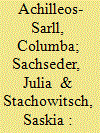

|
|
|
|
|
| Summary/Abstract |
Visuals, including photographs and data visualizations, play a crucial role in the politics of EU border security, both as an internal governance tool (e.g. in surveillance) and as an external means of communication/representation (e.g. in photojournalism). Combining scholarship on photographic representations of migration with literature on surveillance technologies and data visualizations, we argue that these visuals interact to reproduce gendered and racialized meanings of migration and border security. Using a feminist postcolonial lens, we develop an intervisual framework for studying how processes of gendering and racialization render subjects, practices and spaces knowable at the intersection between these visuals. We apply this framework to a case study of Frontex’s Risk Analysis Reports (2010–2021) and demonstrate how it is applicable to other security institutions. The intervisual analysis reveals how the migrant Other and (white) European are visually reproduced through: 1) the (in)visibilization of bodies; 2) the ascription and denial of agency; and 3) the spatialization of borders as ‘frontier imaginings’ that oscillate between fortification and expansionism. The intersectional co-constitution of gender and race, we conclude, is central to the visual politics of Frontex, contributing to problematizing migrants and migration and legitimizing violent border practices.
|
|
|
|
|
|
|
|
|
|
|
|
|
|
|
|
| 2 |
ID:
152109
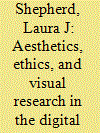

|
|
|
|
|
| Summary/Abstract |
Fifteen years ago, Roland Bleiker’s profound and influential article outlined a research agenda for those who take seriously the nature of aesthetic encounters with the social world. A rich and sophisticated literature addressing theoretical and methodological aspects of visual research in IR has emerged through the ‘aesthetic turn’ in International Relations (IR) theory.1 Efforts to theorise, or represent, global politics that are inspired by an aesthetic approach do not seek to produce the ‘most accurate’ theory or representation. ‘Approaching the study of IR with an aesthetic sensibility encourages scholars to pay analytical attention to affect rather than reason, judgement rather than fact, sensation rather than intellectualism’.
|
|
|
|
|
|
|
|
|
|
|
|
|
|
|
|
| 3 |
ID:
152114
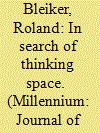

|
|
|
|
|
| Summary/Abstract |
In the 15 years since the Millennium special issue on ‘Images, Narratives and Sounds’ scholarship on aesthetic politics has proliferated.1 Countless inquiries now show how aesthetics is about far more than art: it is about rethinking the fundamental issues that drive global politics. The moment has come to reflect on the contributions of the aesthetic turn and to identify potentials and challenges ahead. I do so by stressing that the key is not agenda-setting, but to continue the search for thinking space: to explore ever new ways of writing, seeing, hearing and sensing the political. I then identify two challenges: first, to push creative work while, at the same time, increasing the ability to speak to a broad audience; and second, to avoid the hubris of overarching explanations and, instead, cultivate pluralism and self-reflexivity. The latter is important to address practices of exclusion, such as those linked to the Western legacy of aesthetic theories.
|
|
|
|
|
|
|
|
|
|
|
|
|
|
|
|
| 4 |
ID:
187145
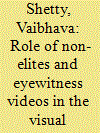

|
|
|
|
|
| Summary/Abstract |
With the advent of smartphones and social media, non-elites possess more resources to engage in politicisation and securitisation of issues. The increasing popularity and acceptance of eyewitness videos captured by non-elites presents new political-security implications, especially for the issue of migration and refugees, as witnessed during the European refugee crisis. The eyewitness videos the host population of Europe captured served as key heuristic artefacts for non-elites to engage in the securitisation and counter desecuritisation of asylum seekers. The production, visual, circulation, and audiencing aspects of eyewitness videos are significantly different from those of professional videos from news media and therefore can potentially articulate (in)security in distinct ways. I argue that the epistemic-political constitution of eyewitness videos and their online remediation through the complex networked act between the calculated security publics and video recommendation algorithms of social media play a key role in facilitating security articulations of asylum seekers. This is illustrated in the analysis of two popular eyewitness videos from Calais. The article examines how non-elites used eyewitness videos to politicise and securitise Calais asylum seekers.
|
|
|
|
|
|
|
|
|
|
|
|
|
|
|
|
| 5 |
ID:
187115


|
|
|
|
|
| Summary/Abstract |
Focusing on the case of ‘Gay Clown Putin’, this article theorizes memes as visual interventions in international politics. While not all memes are political interventions, Gay Clown Putin is an iconic meme that is part of the international response to Russian state-directed political homophobia that emerged after the gay propaganda law was passed in 2013. How it has circulated and the attention it has received make it apt for exploring memes as visual political interventions that challenge national security discourses. Here, I provide three readings of Gay Clown Putin that suggest different possibilities for how the meme might work politically. In so doing, I deepen international relations’ engagement with queer theory by bringing in the politics of play that works through a queer epistemology that embraces deviance. Bringing memes to the study of international security, I show how the collection of images making up the Gay Clown Putin meme provides space for understanding the visual politics of security.
|
|
|
|
|
|
|
|
|
|
|
|
|
|
|
|
| 6 |
ID:
178939


|
|
|
|
|
| Summary/Abstract |
This article establishes that visual displays of sovereignty were central to the escalation and projected legitimacy of a violent non-state actor. Contrary to conventional perspectives, it details that the unprecedented appeal of the so-called Islamic State was tied to a visual projection of statehood. Through an innovative methodology, this study conducts a qualitative, affordance-driven analysis of the global visual politics of Dabiq. It details how photographs taken by Islamic State militants and downloaded from a variety of sources online were strategically utilized as “evidence” of the constitutive criteria of statehood: of a permanent population, a defined territory, a government, and the capacity to enter into relations with other states. It demonstrates that this violent non-state actor utilized the affordances of digital visualizing technologies in order to position itself as a viable and competitive alternative to existing nation-states—as both a destination for migration and a legitimate threat to the established political order. This realization has implications for terrorism studies as well as for the visual politics of non-state actors operating in an era of intense mediatization.
|
|
|
|
|
|
|
|
|
|
|
|
|
|
|
|
| 7 |
ID:
167407
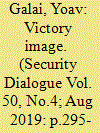

|
|
|
|
|
| Summary/Abstract |
This article interrogates the concept of the ‘victory image’ in Israel as a militarized visual economy. What began as a visual illustration of warfighting became an integral part of operational considerations. My own contribution as an embedded photographer to that economy is used as a prism for larger changes in visual politics. These changes relate to the proliferation of an actuarial gaze as the overarching ordering principle of imaging in the subsequent Gaza Wars. Instead of celebratory images of military achievements, Israeli officials opted for information visualizations to convey a sense of achievement, allowing for the continuation of the ‘visual economy,’ but with Palestinian victims of indiscriminate attacks ignored.
|
|
|
|
|
|
|
|
|
|
|
|
|
|
|
|
| 8 |
ID:
169161


|
|
|
|
|
| Summary/Abstract |
The purpose of this article is to introduce and explore the political potential of visual autoethnography. I do so through my experience of working as a Swiss Army officer in the Korean Demilitarized Zone (DMZ). Drawing on my own photographs I examine how an appreciation of everyday aesthetic sensibilities can open up new ways of thinking about security dilemmas. I argue that visual autoethnography can be insightful not because it offers better or even authentic views – it cannot – but because it has the potential to reveal how prevailing political discourses are so widely rehearsed and accepted that we no longer see their partial, political, and often problematic nature. I illustrate this potential in two ways: (1) how a self-reflective engagement with my own photographs of the DMZ reveals the deeply entrenched role of militarised masculinities; (2) how my positionality and my photographs of everyday life in North Korea show that prevailing security discourses are highly particular and biased, even though they are used to justify seemingly objective policy decisions.
|
|
|
|
|
|
|
|
|
|
|
|
|
|
|
|
| 9 |
ID:
183710


|
|
|
|
|
| Summary/Abstract |
On 26 March 2020, the leaders of the Group of twenty major economies (G20) convened in an emergency virtual meeting to discuss the extraordinary situation facing the world. Virtual summitry provided a stark visual contrast to the traditional staging of modern multilateral diplomacy – leaders were suddenly responsible for their own staging, leaving them with new opportunities to create a favourable impression of how they, and their respective state, would be seen. Taking the disruption of virtual summitry as a starting point, we focus on the resulting new opportunities for visual diplomacy. We draw on the symbolic interactionism of Erving Goffman and we argue that status signalling in this context was based on a shared understanding of the symbols and resources that have social value in the interaction order of summit diplomacy. Based on a visual analysis of 51 photographs from the G20 video conference, we find that the visual performances during the extraordinary meeting reflected evident, but not necessarily intentional, attempts at status seeking. The article thus contributes to an increased understanding of how visual performances contribute to uphold status distinctions in multilateral diplomacy.
|
|
|
|
|
|
|
|
|
|
|
|
|
|
|
|
| 10 |
ID:
182614


|
|
|
|
|
| Summary/Abstract |
The European refugee crisis has been communicated visually through images such as those of Alan Kurdi lying dead on the beach, by body bags on the harbor front of Lampedusa, by people walking through Europe and by border guards and fences. This article examines the broader visual environment within which EU policy-making took place from October 2013 to October 2015. It identifies ‘tragedy’ as the key term used by the EU to explain its actions and decisions and points out that discourses of humanitarianism and border control were both in place. The article provides a theoretical account of how humanitarianism and border control might be visualized by news photography. Adopting a multi-method design and analyzing a dataset of more than 1000 photos, the article presents a visual discourse analysis of five generic iconic motifs and a quantitative visual content analysis of shifts and continuity across four moments in time. The article connects these visual analyses to the policies and discourses of the EU holding that the ambiguity of the EU’s discourse was mirrored by the wider visual environment.
|
|
|
|
|
|
|
|
|
|
|
|
|
|
|
|
| 11 |
ID:
179094
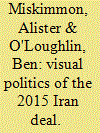

|
|
|
|
|
| Summary/Abstract |
This article explores the role of visuality and narrative in the forging of the 2015 nuclear deal between Iran and the United Nations Security Council P5 + 1. We advance strategic narrative theory by explaining how narrative alignment between longstanding antagonists can occur through protagonists’ coordination of communication – a methodology of orchestration – across public and private spaces of diplomacy. Analysis of news, policy and social media materials as well as interviews with protagonists allows us to trace the gestures and performances through which actors sought to reinforce or overcome an identity narrative of Iran as untrustworthy and dangerous. We draw on Foucault’s concept of alethurgy to show how verification mechanisms were constructed to ensure Iran’s actions (if not its intentions) could be brought into public view. US and Iranian leaders’ political will was significant, and sanctions and sabotage exerted considerable pressure on Iran. This article demonstrates how communication can enable alignment and peace-making rather than confusion and conflict in world affairs.
|
|
|
|
|
|
|
|
|
|
|
|
|
|
|
|
|
|
|
|
|